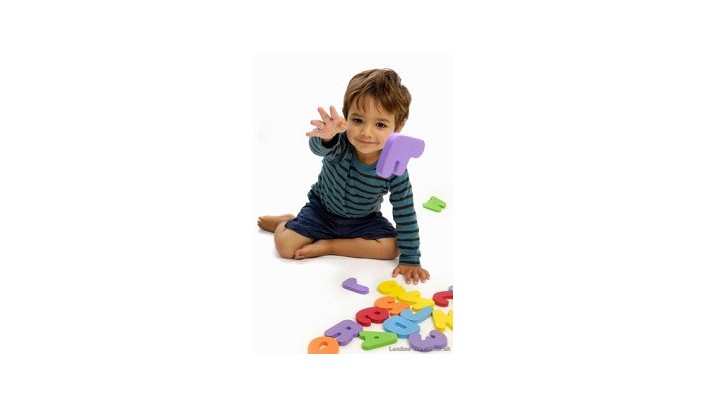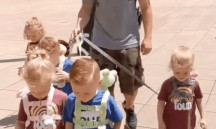Article Categories
News
-
20 July
-
04 November
-
10 July
-
12 June
-
05 June
-
24 September
-
19 September
-
10 May
-
26 April
Website Categories
3 Best Toys for Intellectual Development
 Play Time!
Play Time!Walk into my house on any given day, and you will find yourself at what I'm beginning to consider the world's longest-running block party. My 1-, 2-, and 5-year-olds will all be busy to the point of distraction, happily playing away with blocks. They're usually not building together, mind you (sometimes they're not even in the same room), but each one will be doing his own thing, concentrating intently, and having a blast.
And if they're not using blocks, they're probably having a ball -- that is, playing with one. Which is fine with me, as long as they're not playing ball in the house. But what is it about these toys that makes them such dependable crowd-pleasers? And should my kids be practicing with flash cards rather than pursuing these simple diversions?
Don't Knock Blocks
Blocks are the educational equivalent of a multivitamin. Children playing with blocks aren't just honing their gross and fine motor skills, they're learning everything from fundamental math concepts to problem solving. One study even showed that preschoolers who were adept at playing with blocks had higher math grades and test scores when they got to middle school than those who were not. As Sharon MacDonald, a trainer of early-childhood teachers and author of Block Play (Gryphon House), explains, "When your child works with blocks, he develops an understanding of fractions, shapes, and counting." Of course, it's not as if your 2-year-old is mastering halves and quarters. Math lessons unfold in different stages for different ages.
Three Stages of Block Play
The first phase of block play is what MacDonald terms "tote and carry." Your 2-year-old is doing little or no building, but she can pile, haul, and drop -- and in the process learn about weight, stability, and balance. Of course a toddler's favorite lesson will probably be the noisiest and messiest: gravity. To the outrage of many an older sibling, toddlers learn quickly that what goes up must come down -- and that knocking down blocks brings an exciting reward. "Children like order and structure, but at a young age they love to create chaos even more," says MacDonald. "Just by stacking one block on top of another, they learn that unstable things fall down, while stable things don't."
By the time your child is 3, she'll enter the next phase of block play: "stack and row." Now she can stack the blocks vertically or lay them down and configure them horizontally. She's not building with a specific purpose yet, but she is beginning to try her hand at patterns. The first patterns are usually identical blocks placed on the floor one after another until she adds a twist, such as putting a square after a rectangle, and another square after the next rectangle, and so on. "Math is the study of patterns," says MacDonald, "and encouraging block-patterning lays the foundation for math skills." Here's where fractions come into play. When she puts down two blocks side by side, she can see that, together, they form the same size and shape as one larger block.
In the next stage, "bridging," your preschooler begins to make her own simple structures. She may put two blocks down, then place a third block over the space between them. In addition to learning how to balance, she is beginning to experiment with symmetry. Bridging leads to "enclosures." You can't build without being able to organize and enclose space. How am I going to fill that space? is a complicated question, requiring that your child figure out how many big and small blocks are needed to get the job done. Not only is your child planning ahead, but she is problem solving.
Having a Ball of a Time
Play Ball!
Blocks aren't the only powerhouse in the playroom. Even infants can follow a ball with their eyes as it rolls across the floor. In doing so, says Maureen Maiocco, early-childhood program director at SUNY Canton, in Canton, New York, they "must follow the direction and anticipate the location of the ball as it moves toward them." This kind of visual tracking helps coordinate your baby's eye movements with his body's movements. Plus, predicting when the ball will reappear reinforces the idea that when something disappears from sight, it's not necessarily gone for good.
When babies are older and can crawl after the ball, they are working on spatial awareness -- How far away is that ball? Where is my body in relation to it? As toddlers become preschoolers, spatial awareness leads to logical thinking. Now that they're getting the hang of throwing and catching, they have to start figuring out how hard to throw and in which direction. In other words, they have to estimate the parameters in which they can throw and catch.
Your preschooler is likely to take ball play deep into scientific exploration. When he sends a ball rolling down a slide, for example, he realizes that different-size balls roll down slides at different speeds. Emily Vosper, director of the Children's Center at SUNY Ulster County Community College, in Stone Ridge, New York, describes the process as "higher-level thinking arising from basic tools." Also known as physics for 4-year-olds.
How Cups Stack Up
When my kids play with stacking cups, I like to think of it as good practice for emptying the dishwasher, but they're actually stockpiling math and science skills. Sometime between his first and second birthday, he'll be able to place the cups on top of one another. He's usually not stacking them in any order, but he's starting to understand size relationships. Don't pressure him to do it the "right" way. As he gets older, he'll realize, If I put the small cup inside the big one, the medium one won't fit. He's starting to understand seriation -- a fancy word for putting things in their proper order.
Babies can spend hours filling and dumping cups in the tub or sandbox. As they begin to notice the difference between empty and full, they're getting an inkling about volume. He can see that he can fit lots of little cups of sand into the biggest cup, but pouring from biggest to smallest results in an avalanche.
Just Add Water!
Water play adds another splash of science. As John Cerio, PhD, a professor of school psychology at Alfred University, in Alfred, New York, points out, kids are capable of learning a difficult concept on a very basic level. If you pour water from one container into a different-shaped container, you still have the same amount of water. Without hands-on play, most kids would tell you that the taller container must hold more.
There you have it. Blocks, balls, and cups -- unsung superheroes of the toy world. So what's their secret? Some experts believe that convergent playthings (with only one purpose, such as puzzles) encourage children to seek out the one correct answer while divergent playthings (with more than one purpose) guide children to many approaches, helping them understand that some problems have many solutions. That must be why kids go back to these toys again and again. They'll never be the must-have toys of the moment, but they won't be forgotten tomorrow either.
Toy Chest Friends
As every parent knows, no toy chest is complete without an assortment of stuffed animals, dolls, and action figures. While you may feel your house is overrun with them, they are pulling their weight: They play a big role in the development of imagination.
"When your toddler cooks dinner for his furry friend or gives him a bath, he is practicing adult roles in a way that helps him make sense of the world," says Amy Flynn, director of the Bank Street Family Center, in New York City. Preschoolers get even more dramatic by giving their dolls and stuffed animals human qualities as they act out conflicts and frustrations. You may walk in on your 3-year-old as she's angrily telling her stuffed animal, "You're going in to time-out!" (You won't be the only mom who feels slightly horrified, wondering if that's how you sound to your child!) Next, you may see reenactments of events, but with an outcome that suits your child better -- for example, letting all her dolls have cookies before dinner.
One of pretend play's biggest benefits, says Flynn, is that "it gives children a safe haven to explore their feelings while feeling in control." In other words, the dolls and bears in your life are helping kids come to grips with their emotions.
Related articles
Parenting is no easy task, and for Jordan and Briana Driskell, raising their quintuplets—Zoey, Dakota, Hollyn, Asher, and Gavin&mdash...
Read moreFocus on back to school - include a free...
Emma WallaceThe summer holidays are drawing to a close and September sees pupils heading back to the classroom. Alongside buying new uniform and statio...
Read moreA Starbucks employee went viral after sharing a video where they broke down in tears due to being scheduled for an eight-hour shift. ...
Read more0 comments
No messages yet




